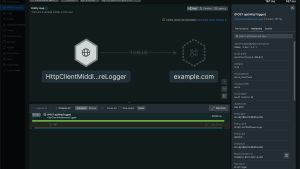Azure virtual machines (VMs) stand out for their scalability, flexibility, and cost-efficiency. Yet, as with any technology, they're not immune to challenges. For developers navigating these challenges, New Relic infrastructure monitoring emerges as a beacon, offering deep insights into Azure VMs and facilitating swift issue resolution.
Overview of Azure VMs and infrastructure monitoring
Azure virtual machines (VMs) are a core offering within Microsoft's vast cloud ecosystem, providing developers with the ability to deploy virtualized computing environments on-demand. These VMs are highly customizable, allowing for a range of configurations to suit specific application and workload requirements. With such customization comes complexity, making monitoring and management crucial for optimal performance and reliability.
Azure VMs: A developer's perspective
Azure VMs offer a sandboxed environment where developers can run applications, test new software, or even simulate entire production environments. They support a wide range of operating systems, programming languages, frameworks, databases, and devices. This versatility means developers can:
- Rapidly prototype: Spin up VMs to test new ideas or features without impacting the main production environment.
- Scale efficiently: Adjust resources based on demand, ensuring applications remain responsive during peak loads.
- Maintain consistency: Use templated VM configurations to ensure uniformity across development, staging, and production environments.
However, this flexibility can also introduce challenges. Misconfigurations, resource constraints, or software incompatibilities can sometimes lead to performance bottlenecks or system failures.
The imperative of infrastructure monitoring
New Relic includes powerful infrastructure monitoring tools that are designed to provide visibility into the health, performance, and security of Azure VMs. For developers, this means:
- Real-time performance metrics: Monitor CPU usage, memory consumption, disk I/O, and network activity. Identify resource constraints that could be affecting application performance.
- Error and anomaly detection: Receive alerts for unusual activity or system errors. This proactive approach can help developers address issues before they escalate, minimizing downtime.
- Configuration monitoring: Track changes to VM configurations. This is especially useful in identifying unintended changes that might impact system performance or stability.
- Security insights: Monitor for unauthorized access attempts, potential security breaches, or vulnerabilities. Ensure that the VM environment remains secure and compliant.
Azure VM common breakdowns
Azure VMs can face a myriad of issues, each presenting unique challenges for developers:
- Network connectivity: VMs might lose connection, disrupting services and applications.
- Performance: High CPU usage, memory constraints, or slow response times can bottleneck development tasks.
- Storage: Disk space issues or lagging disk performance can hinder data-intensive operations.
- Security: Unauthorized access can jeopardize sensitive data and application integrity.
- Configuration: Misconfigured VM settings can lead to operational challenges, affecting deployment and runtime.
- Application issues: Software errors within the VM can cause application crashes, affecting development and deployment.
Importance of effective troubleshooting for Azure VMs
For developers, an issue in Azure VMs can mean disrupted workflows and compromised projects. Effective troubleshooting, backed by robust tools, ensures that issues are pinpointed and rectified promptly, keeping development cycles smooth and efficient.
The complexity of Azure VM environments
Azure VMs, while powerful, operate within intricate ecosystems, interacting with various Azure services, external applications, and databases. This interconnectedness, while beneficial for creating robust applications, also means that a single issue can have cascading effects throughout the system.
- Interdependencies: An Azure VM might rely on multiple services, like Azure Blob Storage for data or Azure SQL Database for backend operations. A bug in any of these services can impact the VM's performance.
- Custom configurations: Azure VMs can be tailored to specific needs, from the operating system to the software stack. This level of customization introduces variability, making troubleshooting more challenging.
The business implications of VM downtime
Even minor downtimes can have significant repercussions:
- Operational disruptions: For businesses that rely on Azure VMs for critical operations, any downtime can halt processes, leading to operational inefficiencies.
- Financial impact: Downtime can lead to direct revenue loss, especially for businesses that operate online platforms or ecommerce sites.
- Reputational damage: Frequent outages or performance issues can erode customer trust, leading to long-term reputational damage.
Embracing a proactive approach to troubleshooting Azure VMs
In the realm of cloud computing, where systems are dynamic and intricately interconnected, a reactive approach to troubleshooting can be costly in terms of time, resources, and business impact. Instead, a proactive stance, where potential issues are anticipated and addressed before they escalate, is increasingly recognized as the gold standard. Let's delve deeper into the nuances of a proactive troubleshooting approach for Azure VMs and why it's a game changer for developers and IT professionals.
Understanding the proactive paradigm
At its core, proactive troubleshooting is about anticipation. It's the difference between waiting for a system to fail and actively monitoring and analyzing system health to prevent failures. This forward-thinking strategy minimizes downtime by catching and resolving potential problems early and optimizes resource utilization. By being proactive, both human and computational resources are used more efficiently, sidestepping the chaos and rush that typically follow unexpected system breakdowns.
Key elements of proactive troubleshooting for Azure VMs
- Real-time monitoring: Continuous tracking of system metrics, performance indicators, and operational statuses are crucial. Real-time monitoring provides an ongoing snapshot of system health, allowing for immediate detection of anomalies or performance degradations. New Relic plays a pivotal role here by offering comprehensive monitoring capabilities tailored for Azure VMs. Its platform captures a wide range of data points, from CPU usage to network activity, and presents them in intuitive, customizable dashboards. This granularity ensures that developers have a clear view of VM health at all times.
- Automated alerts: Setting predefined thresholds for various metrics, beyond which automated alerts are triggered, is essential. These alerts ensure that potential issues are flagged immediately, allowing for swift interventions. The New Relic alerting system is both robust and flexible in this regard. Developers can set up specific alert conditions for their Azure VMs, ensuring that they're notified instantly when predefined thresholds are breached. This immediate notification allows for rapid response, minimizing potential impacts.
- Log analysis: A systematic examination of system logs to identify patterns, errors, or unusual activities is invaluable. Logs often contain detailed information about system operations, and analyzing them can offer insights into the root causes of issues. New Relic integrates log management capabilities, allowing developers to correlate log data with performance metrics. This correlation provides a holistic view of system operations, making it easier to pinpoint anomalies or potential issues.
- Performance benchmarking: Regularly testing and measuring system performance against established benchmarks is a proactive measure. Benchmarking helps identify performance degradation over time. With New Relic, developers can set performance baselines for their Azure VMs and compare real-time performance against these benchmarks. Any deviations from the norm can be quickly identified and addressed, ensuring consistent VM performance.
- Predictive analysis: Using historical data and advanced algorithms to predict future system behavior or potential issues is a forward-thinking approach. Predictive analysis can forecast potential system bottlenecks, capacity constraints, or resource shortages. While New Relic provides a wealth of historical data, its integration capabilities with other tools can facilitate predictive analysis. By leveraging this historical data in conjunction with predictive algorithms, developers can gain insights into potential future challenges and proactively address them.
The bigger picture
Embracing a proactive approach to troubleshooting doesn't just benefit the immediate system or application—it has broader organizational implications. It fosters a culture of anticipation and preparedness, where teams are always a step ahead, ensuring business continuity and optimal user experience.
Conclusion
For developers working with Azure VMs, New Relic infrastructure monitoring is more than just a tool—it's a game changer. It offers the depth and granularity needed to navigate the complexities of Azure VMs, ensuring smooth operations and efficient troubleshooting. With New Relic, developers can harness the full potential of Azure VMs, optimizing their cloud projects and applications.
Next steps
Eager to streamline your Azure VM troubleshooting with infrastructure monitoring? Enhance your expertise with New Relic and take your Azure VM management to the next level with these resources:
- Explore how ZenHub achieved operational excellence with New Relic's infrastructure monitoring solutions.
- Build resilient Azure VM systems with best practices for performance monitoring and diagnostics.
Don’t have New Relic? Sign up for free. Your account includes up to 100GB/month of free data ingest, one full-platform user, and unlimited basic users.
The views expressed on this blog are those of the author and do not necessarily reflect the views of New Relic. Any solutions offered by the author are environment-specific and not part of the commercial solutions or support offered by New Relic. Please join us exclusively at the Explorers Hub (discuss.newrelic.com) for questions and support related to this blog post. This blog may contain links to content on third-party sites. By providing such links, New Relic does not adopt, guarantee, approve or endorse the information, views or products available on such sites.


